

Gray Wolf (Canis lupus) - California Department of Fish and Wildlife. On Dec. 28, 2011 a 2 ½-year-old, male gray wolf entered California after traveling from northeast Oregon.

Designated OR7, his behavior, called dispersal, is not atypical of a wolf his age. Historically, wolves inhabited California, but were extirpated. Before OR7, the last confirmed wolf in California was here in 1924 and since then, investigated “sightings” have turned out to be coyotes, dogs, wolf-dog hybrids, etc. CDFW wildlife managers anticipated that wolves would eventually enter California, and have been preparing for it. The State of California is not intentionally reintroducing wolves. CDFW provides these maps to show the route that Wolf OR 7 has traveled since his entry into California.
Map of OR7's path in California (PDF) This map contains data through April 23, 2013 On March 12/13, 2013, Wolf OR7 returned to Oregon then made a brief return to California on April 20, 2013. Western Gray Wolf: U.S. Fish and Wildlife Service. Wolf restoration in the Northern Rocky Mountains (NRM) has been an amazing success thanks to both the resiliency of wolves and the cooperative efforts of Federal, State, and Tribal agencies, conservation groups, and private citizens; including ranchers, sportsmen, and outfitters.
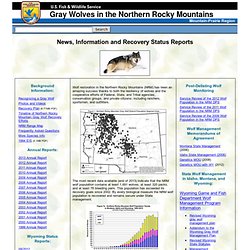
The most recent data available (end of 2013) indicate that the NRM wolf population contains at least 1,691 wolves, at least 320 packs, and at least 78 breeding pairs. This population has exceeded its recovery goals since 2002. By every biological measure the NRM wolf population is recovered and remains secure under State management. Long-term, the Service expects the entire NRM population to maintain a long-term average of around 1,000 wolves.
Wolf Management in Alaska with an Historic Perspective, Alaska Department of Fish and Game. Presentation to the Alaska Board of Game March 2002 by Wayne L.
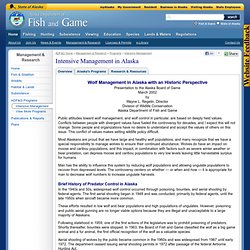
Regelin, Director Division of Wildlife Conservation Alaska Department of Fish and Game Public attitudes toward wolf management, and wolf control in particular, are based on deeply held values. Conflicts between people with divergent values have fueled the controversy for decades, and I expect this will not change. Some people and organizations have no desire to understand and accept the values of others on this issue.
This conflict of values makes setting wildlife policy difficult. Most Alaskans are proud that we have large and healthy wolf populations, and many recognize that we have a special responsibility to manage wolves to ensure their continued abundance. Man has the ability to influence this system by reducing wolf populations and allowing ungulate populations to recover from depressed levels. Arizona Mexican Wolf Conservation and Management. The Arizona Game and Fish Department has been actively involved in reintroducing Mexican wolves to portions of their historical range for many years.
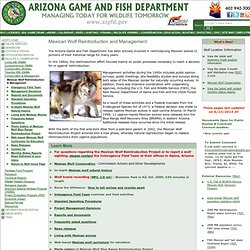
In the 1980s, the reintroduction effort focused mainly on public processes necessary to reach a decision for or against reintroduction. Management activities during the 1990s included public opinion surveys, public meetings, site feasibility studies and surveys along both sides of the Mexican border for naturally occurring wolves. In addition, there was intensive coordination with cooperating agencies, including the U.S. Colorado Parks & Wildlife - Gray Wolf Management. Sign In Calendar FAQs Contact Us <div id="ctl00_ContentPlaceHolder1_SmallSearchInputBox1_noscript">It looks like your browser does not have JavaScript enabled.

Please turn on JavaScript and try again. </div> Idaho Fish and Game - Wolves - Wolf Management. Wolves in the Wild Wolves are highly social animals, and the family structure is focused around the pack.
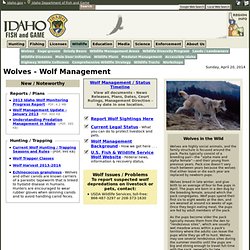
Packs typically consist of a breeding pair—the “alpha male and alpha female”—and their young from previous years. Pack size doesn’t vary much between years because the wolves that either leave or die each year are replaced by newborn pups. Wolves in Michigan. Browsers that can not handle javascript will not be able to access some features of this site.

<br> Skip Navigation MI.gov Department of Natural Resources | DNR close print view Sign up for email from the DNR. Wolf Management: Minnesota DNR. Federal court ruling makes killing wolves illegal Effective Dec. 19, 2014, Minnesotans can no longer legally kill a wolf except in the defense of human life.
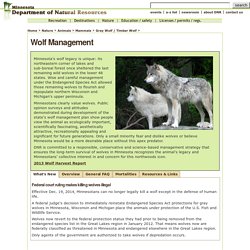
A federal judge's decision to immediately reinstate Endangered Species Act protections for gray wolves in Minnesota, Wisconsin and Michigan place the animals under protection of the U.S. Fish and Wildlife Service. Wolves now revert to the federal protection status they had prior to being removed from the endangered species list in the Great Lakes region in January 2012. That means wolves now are federally classified as threatened in Minnesota and endangered elsewhere in the Great Lakes region. Only agents of the government are authorized to take wolves if depredation occurs. Montana Wolf Program. FWP obtained full authority to manage wolves in Montana upon the federal delisting of the Rocky Mountain gray wolf in May 2011.
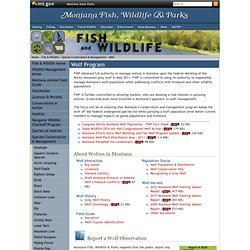
FWP is committed to using its authority to responsibly manage Montana’s wolf population while addressing conflicts with livestock and other wildlife populations. FWP is further committed to allowing hunters, who are showing a real interest in pursuing wolves, to become even more involved in Montana’s approach to wolf management. The focus will be on ensuring that Montana’s conservation and management program keeps the wolf off the federal endangered species list while pursuing a wolf population level below current numbers to manage impacts on game populations and livestock.
New Mexico: Mexican Gray Wolf Recovery Program. North Dakota Ecological Services Field Office: U.S. Fish and Wildlife Service. Oregon Dept of Fish and Wildlife: Gray Wolves. Division of Wildlife Resources. Updated, March 6, 2012 Information regarding the future of wolves in Utah Possible wolf sightings Possible wolf sightings in north-central Utah: On March 4, while performing coyote removal in the area, a helicopter crew of USDA-Wildlife Services employees saw a group of four animals that appeared to be either wolves or wolf-dog hybrids.
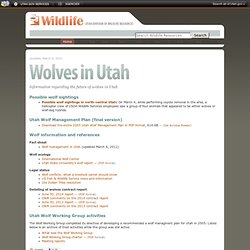
Utah Wolf Management Plan (final version) Download the entire 2005 Utah Wolf Management Plan in PDF format, 616 KB — (Get Acrobat Reader) Washington Gray Wolf Conservation & Management. Wisconsin Gray wolf program. Wyoming Game & Fish Department.